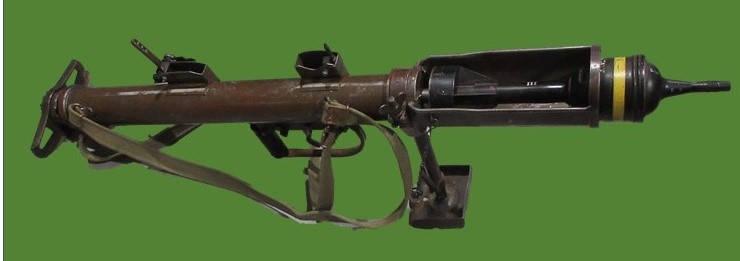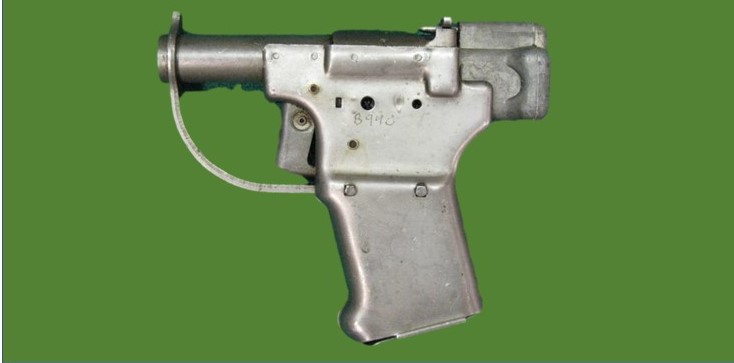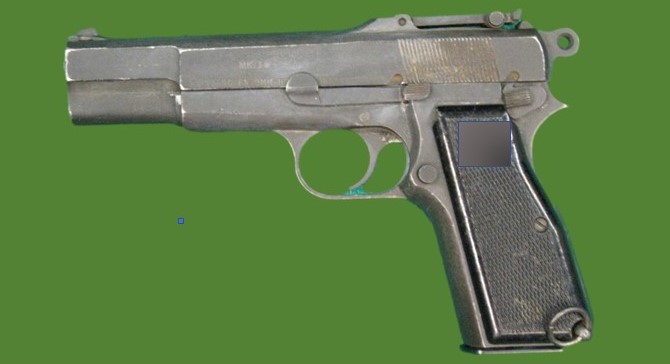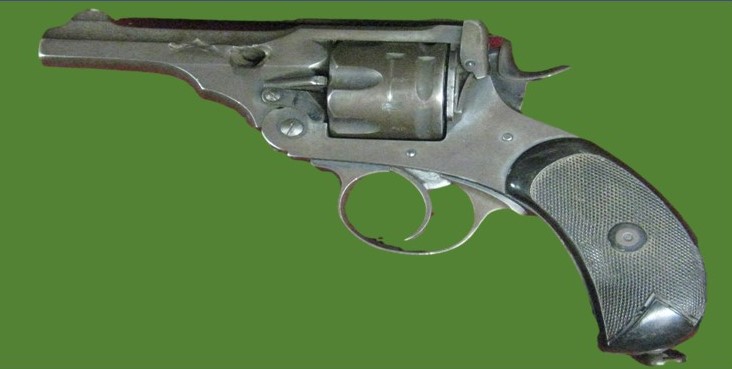Firearms
The museum has an outstanding collection of firearms dating from the mid-1800s until the last decade. All firearms are displayed and stored in accordance with Canadian firearms security regulations.The following are some examples of the firearms in the collection:
Pre – World War One

1797 India Pattern Musket
“Brown Bess” is a nickname of uncertain origin for the British Army’s muzzle-loading smoothbore flintlock Land Pattern Musket and its derivatives. The musket design remained in use for over a hundred years with many incremental changes in its design. These versions include the Long Land Pattern, the Short Land Pattern, the India Pattern, the New Land Pattern Musket and the Sea Service Musket.
The Long Land Pattern musket and its derivatives, all 0.75 inch calibre flintlock muskets, were the standard long guns of the British Empire’s land forces from 1722 until 1838, when they were superseded by a percussion cap smoothbore musket. In all, more than 1,600,000 India-pattern Brown Bess muskets were manufactured between 1804 and 1815. As well as British usage, some were also carried by King George’s allies, among them the Russians and Prussians. . Click here for more information

Martini-Henry Mark I 1873
The Martini–Henry is a breech-loading single-shot lever-actuated rifle that was used by the British Army. It first entered service in 1871, eventually replacing the Snider–Enfield, a muzzle-loader converted to the cartridge system. Martini–Henry variants were used throughout the British Empire for 47 years. Click here for more information. Click here for more information

Lee-Enfield Carbine 1898
The Lee–Enfield rifle was introduced in November 1895 as the .303 calibre, Rifle, Magazine, Lee–Enfield, or more commonly Magazine Lee–Enfield, or MLE (sometimes spoken as “emily” instead of M, L, E). The next year, a shorter version was introduced as the Lee–Enfield Cavalry Carbine Mk I, or LEC, with a 21.2-inch (540 mm) barrel as opposed to the 30.2-inch (770 mm) one in the “long” version.
The Canadian contingents of troops that were sent to South Africa, although rode horses they were not cavalry, but were Mounted Rifles. They rode to the battle then dismounted and fought like infantry. They carried the MLE long rifle slung across their back. The museum’s Mk.I LEC is one of 2300 carbines purchased by the Canadian govt in 1896. Click here for more information
World War One

Cup Grenade Launcher
While rifle-launched grenades date back hundreds of years, they first came into widespread use during World War One, on all sides of the conflict. The first years of the war saw the use of rod grenades, but their downsides (mediocre accuracy, bulkiness, and a propensity to damage rifle bores) led to the British adopting a 2.5” cup grenade discharger in late 1917. This new launcher used slightly modified Mills bomb hand grenades, and could launch them with significant accuracy from 80 to 200 yards. They would become a staple of WWI combined arms infantry tactics, and be used clear through WW2 until replaced by the 22mm NATO style spigot grenades. Click here for more information.

Ross Rifle
During the South African War of 1899–1902, Canada asked Britain to supply Canadian soldiers with the British Lee-Enfield rifle commonly used by British troops. Britain refused, due to Lee-Enfield supply shortages. The Birmingham Small Arms Company, which made the Lee-Enfield, would also not license the rifle for production in Canada. A new, Canadian-made weapon would have to be designed.
Sir Charles Ross, a British aristocrat and inventor, offered to build a small-arms factory in Canada. He also proposed a rifle of his own design as Canada’s first domestically produced military rifle. The Canadian government under Robert Borden was enthusiastic about the idea of having a rifle produced in Canada as opposed to in Britain. It approved the deal in 1901 without properly testing the Ross rifle.
Click here for more information.

1916 Berthier French Fusil Mle 1907/15-M16
During World War I, a modified version of the 3-round clip Mle 1907 rifle called Fusil Mle 1907/15 was manufactured in large numbers (altogether 435,000 rifles) and issued to colonial troops, to the French Foreign Legion and to many minor allies. However, the limited ammunition capacity of the Berthier Mle 1907/15’s magazine (3 rounds) was viewed as a great disadvantage by troops in close contact with the enemy or participating in assaults or trench raids.In response, French military authorities introduced a modified Berthier rifle in 1916, designated Fusil Mle 1907/15-M16 but generally called the 1916 rifle (Fusil Modele 1916). The new rifle had a re-designed magazine well, which now could hold “en-bloc” clips with a 5-round capacity, though they would still accept the original 3-round chargers. With its greater cartridge capacity, it was better received than the Mle 1907/15 rifle and later became widely issued to infantry troops during the post-war years after their production had intensified. Click here for more information.
World War Two

Projector, Infantry, Anti Tank (PIAT) Mk I
The PIAT was designed in 1942 in response to the British Army’s need for a more effective infantry anti-tank weapon and entered service in 1943.
The PIAT was based on the spigot mortar system, and projected (launched) a 2.5 pound (1.1 kg) shaped charge bomb using a cartridge in the tail of the projectile. It possessed an effective range of approximately 115 yards (105 m) in a direct fire anti-tank role, and 350 yards (320 m) in an indirect fire role. Click here for more information and technical detail.

FP-45 Liberator Pistol
The Liberator was a crude and clumsy single-shot 45 cal pistol designed to be cheaply and quickly mass-produced. The original delivered cost for the FP-45 was $2.10/unit, lending it the nickname “Woolworth pistol”. Five extra rounds of ammunition could be stored in the pistol grip. It was originally intended as an insurgency weapon to be mass dropped behind enemy lines for resistance fighters to recove and kill or incapacitate an Axis occupier and retrieve his weapons. Click here for more information.

Inglis P35 Pistol
Inglis produced two versions of the Hi-Power, one with an adjustable rear sight and detachable shoulder stock and one with a fixed rear sight. Production began in late 1944 and they were on issue by the March 1945 Operation Varsity airborne crossing of the Rhine into Germany. The pistol was popular with the British airborne forces as well as covert operations and commando groups such as the Special Operations Executive (SOE), the U.S. Office of Strategic Services (OSS) and the British Special Air Service (SAS) Regiment. Click here for more information

Maschinenpistole 40 (Machine Pistol 49/MP40)
The MP 40 machine pistol The MP 40, often called the “Schmeisser” by the Allies, was an open-bolt, blowback-operated automatic arms. The only mode of fire was fully automatic, but the relatively low rate of fire enabled single shots with controlled trigger pulls.
To save time and materials, and thus increase production, construction of the MP 40 receiver was simplified by using stamped steel and electro-spot welding as much as possible. Click here for more information.

Webley Mk V Revolver
The Webley Mk V, adopted in 1913, was the standard British service revolver at the outbreak of the First World War. It was one of a series of Webley revolvers which were the standard issue pistols of the British Army from 1887 onwards. Of the six standard Webley service revolver “Marks” adopted between 1887 and 1915, Webley mdae fewer Mark V revolvers than any other, and collectors consider them among the rarest. . Click here for more information.
Cold War and Beyond

US M14 Rifle
The M14 rifle, officially the United States Rifle, Caliber 7.62 mm, M14, is an American select-fire battle rifle that fires 7.62×51mm NATO (.308 in) ammunition. It became the standard-issue rifle for the U.S. military in 1959 replacing the M1 Garand rifle in the U.S. Army by 1958 and the U.S. Marine Corps by 1965 until being replaced by the M16 rifle beginning in 1968. The M14 was developed from a long line of experimental weapons based upon the M1 Garand rifle. Although the M1 was among the most advanced infantry rifles of the late 1930s, it was not an ideal weapon. Modifications were already beginning to be made to the basic M1 rifle’s design during the last months of World War II. Changes included adding fully automatic firing capability and replacing the eight-round en bloc clips with a detachable box magazine holding 20 rounds. Click here for more information

Canadian FN C1A1 Rifle
The FN L1A1 Self-Loading Rifle, also known as the SLR (Self-Loading Rifle), is a British version of the FN FAL battle rifle produced by the Belgian armaments manufacturer FN Herstal. The L1A1 was produced under licence and has seen use in the Australian Army, Canadian Army, Indian Army, Jamaica Defence Force, Malaysian Army, New Zealand Army, Rhodesian Army, Singapore Army and the British Armed Forces.
Canada adopted the FAL in 1954, the first country in the world to actually ante up and order enough rifles for meaningful troop trials. Up to this point, FN had been making these rifles in small test lots of ones and twos, each embodying changes and improvements over its predecessor. The Canadian order for 2,000 rifles “cast the FAL in concrete” for the first time, and at FN, from 1954 to 1958 the standard model of the FAL rifle was called the FAL ‘Canada’…These excellent Canadian-built rifles were the standard arms of the Canadian military from first production in 1955 until 1984. Click here for more information.

Canadian C7A2 Rifle
The C7 was the first fully automatic weapon issued to Canadians as a standard service rifle. The C7 offered many distinct improvements over the American M16 on which it was modeled and was produced in Canada by Diemaco of Kitchener, Ontario. Some of the major changes to the American weapon were full automatic capability as opposed to 3 round burst, one extra twist to the rifling for improved accuracy, and plastic better able to withstand arctic conditions. The C7 was originally equipped with plastic “disposable” magazines, but since they were not produced in quantities high enough to allow them to be truly disposable the plastic magazines were eventually disposed of and replaced with a metal US-designed 30 round magazine. Click here for more information.
